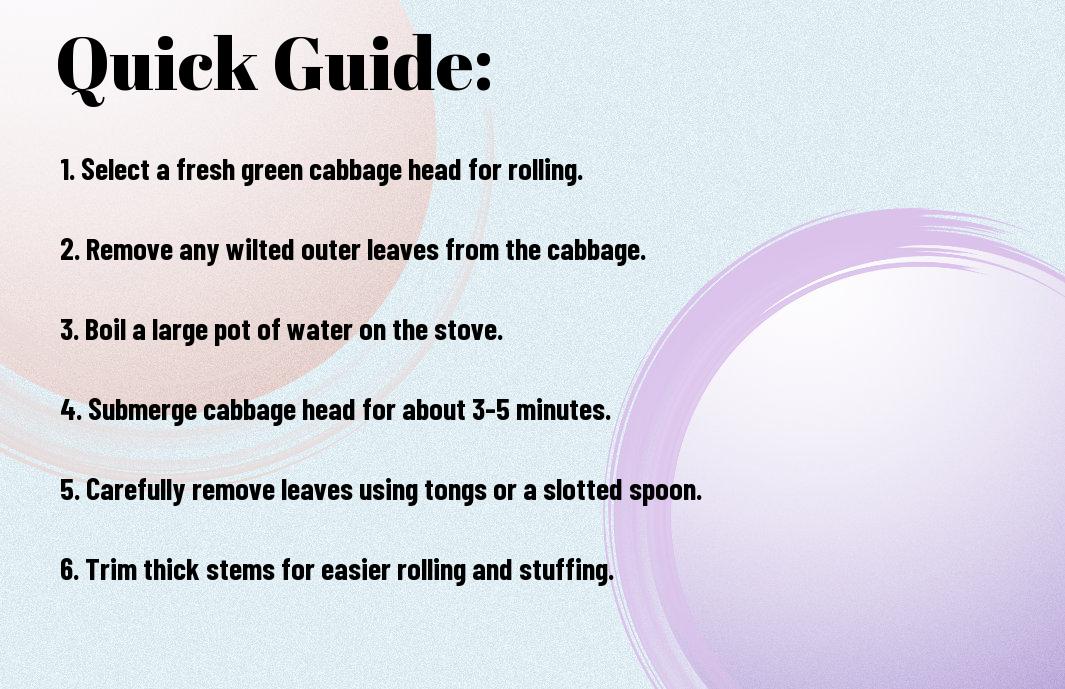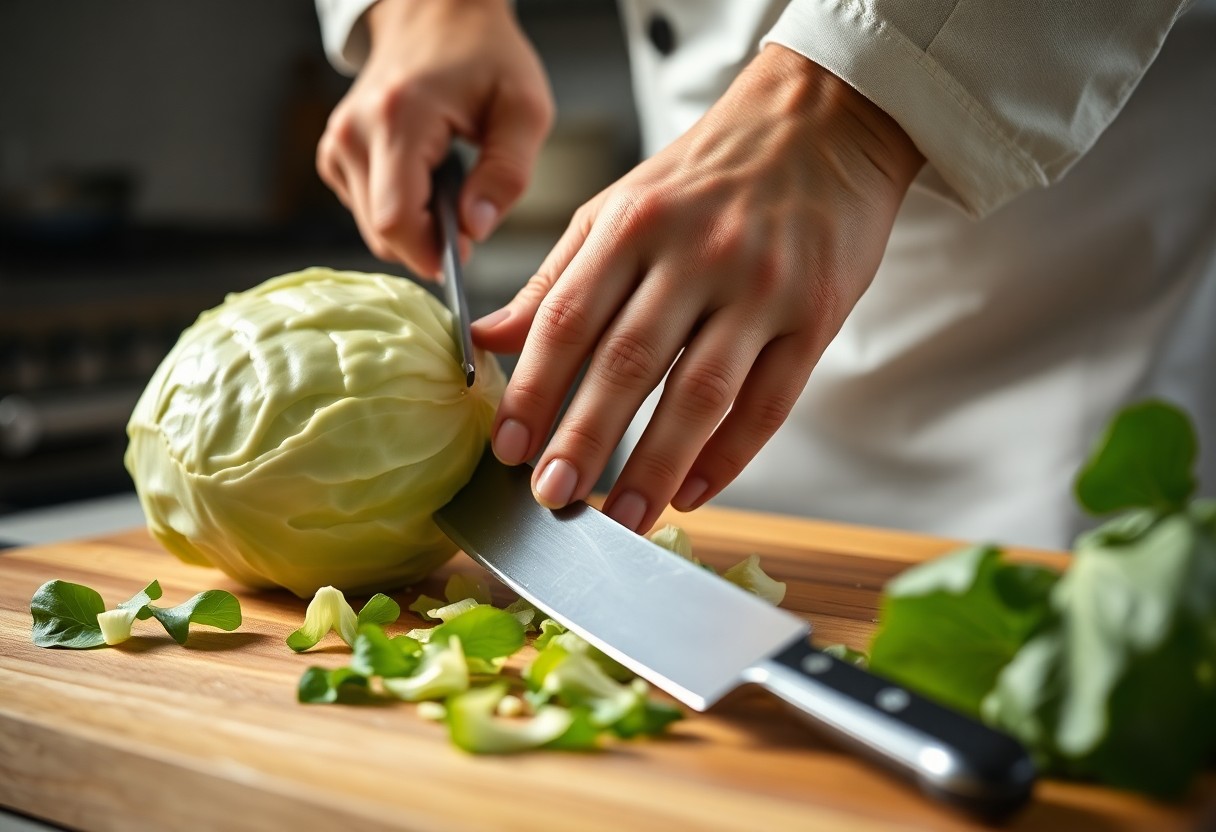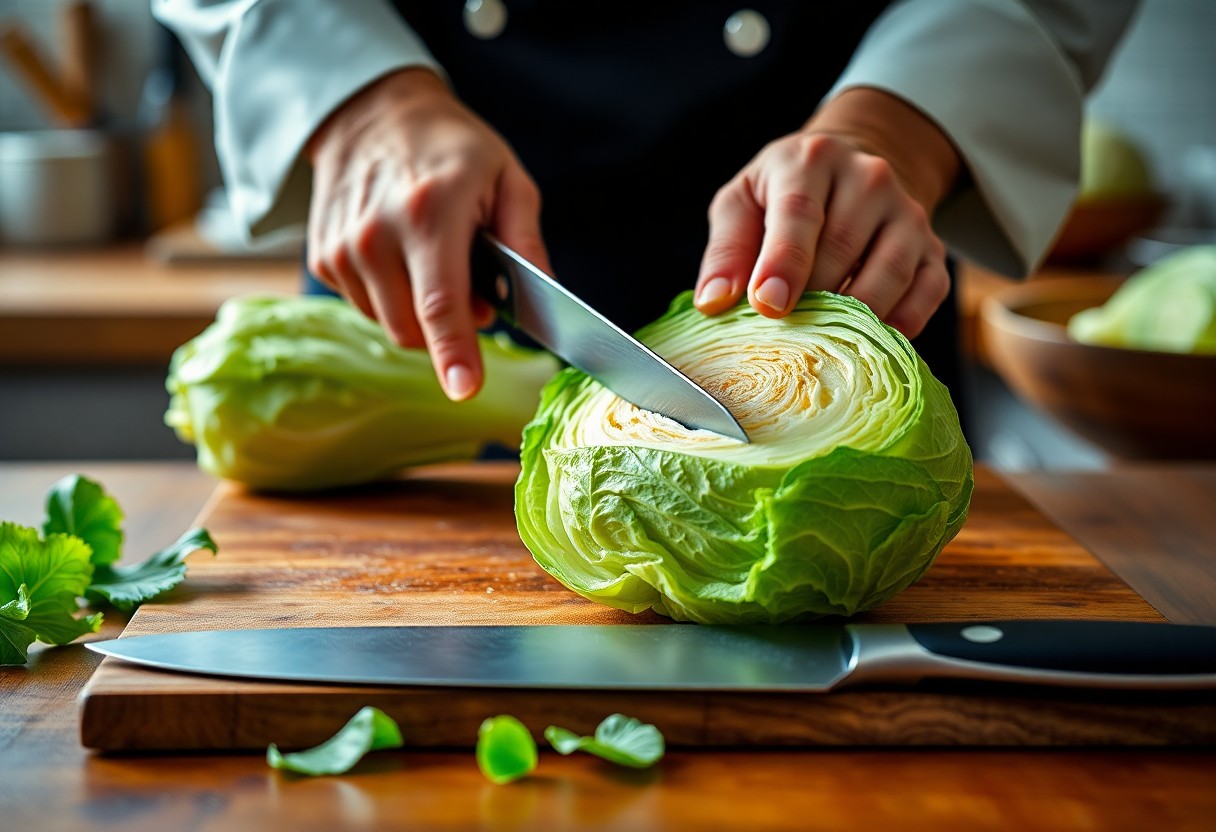This guide will help you master the art of cutting cabbage for delicious cabbage rolls. By following this step-by-step process, you will ensure that your cabbage leaves are not only easy to work with but also perfectly suited for wrapping your favorite fillings. Whether you are a seasoned cook or a beginner, each step is designed to enhance your cooking experience and minimize the risk of injury while using a knife. Let’s get started on making those delectable rolls!
Key Takeaways:
- Blanching the cabbage is imperative to soften the leaves, making them easier to roll without tearing.
- Using a sharp knife and a stable cutting board will help achieve clean, even cuts when removing the core and separating the leaves.
- Keeping the cabbage head whole until preparing helps maintain the structure and moisture of the leaves for better filling and rolling.
Types of Cabbage for Rolls
Before you begin crafting delicious cabbage rolls, it’s important to understand the different types of cabbage that can elevate your dish. Here are some popular options:
- Green Cabbage
- Savoy Cabbage
- Napa Cabbage
- Red Cabbage
- Pointed Cabbage
Thou will find that each variety offers unique textures and flavors for your rolls.
Green Cabbage
With its sturdy leaves and mild flavor, green cabbage is the most common choice for cabbage rolls. It holds up well during cooking, making it easy to wrap around your favorite filling while maintaining a satisfying crunch.
Savoy Cabbage
Little do many know, Savoy cabbage brings a beautiful, crinkled texture and a slightly sweeter taste to your rolls. It’s also more tender than green cabbage, making it easier to work with when wrapping.
For instance, Savoy cabbage is less fibrous, which means you can enjoy healthier rolls without the off-putting toughness found in other varieties. Its unique texture enhances the rolls while its leaves provide excellent leaf coverage. Using Savoy cabbage can elevate your dish not only in flavor but also in presentation, enticing everyone at the table. However, be cautious while handling its leaves, as they are more prone to tearing compared to sturdier types.

Factors to Consider When Cutting Cabbage
While preparing to cut cabbage for your rolls, several important factors should guide your process:
- Type of cabbage
- Size and shape of the cabbage head
- Desired thickness of the rolls
Knowing these factors will make your cabbage cutting process more effective and your rolls more delicious.
Cabbage Size and Shape
Assuming you have a variety of cabbages available, their size and shape can significantly affect the cutting process. Larger heads are often easier to work with, while smaller varieties may require more careful handling. Always select a cabbage that feels firm and has minimal blemishes to ensure the best results in your rolls.
Desired Roll Thickness
Factors like the desired thickness of your cabbage rolls will play a significant role in how you cut. A standard thickness is about 1/4 inch as it allows for even cooking and a satisfying bite. When you cut too thick, you risk undercooking the cabbage or making it challenging to roll. On the other hand, if the pieces are too thin, they may tear during the rolling process. Consider using a sharp knife and a steady hand to achieve uniform cuts, as even slicing ensures consistency across your cabbage rolls.

Step-by-Step Cutting Guide
To master the art of cutting cabbage for rolls, follow this structured approach outlined in the table below:
| Step | Description |
|---|---|
| 1 | Choose a fresh, firm cabbage. |
| 2 | Remove any outer leaves that are damaged. |
| 3 | Core the cabbage to facilitate easier cutting. |
| 4 | Slice the cabbage into halves or quarters for easier handling. |
| 5 | Shred or cut into desired sizes for rolling. |
Preparing the Cabbage
You will want to start by selecting a head of cabbage that feels heavy for its size, ensuring it is fresh. Remove any wilting or damaged outer leaves, and rinse the cabbage thoroughly under cold water. By coring it, you can remove the tough center, making the leaves easier to separate for your rolls.
Cutting Techniques
Guide your knife steadily through the cabbage by employing proper cutting techniques. Utilize a sharp knife for precision and ease, and always cut away from your body to ensure safety. Aim for uniform pieces, about a quarter-inch thick, allowing for even cooking and easier rolling of your cabbage rolls.
To achieve optimal results, you should maintain a steady angle while cutting and apply even pressure. If you find some leaves are difficult to cut, consider blanching them lightly in boiling water beforehand; this process softens the leaves, making them more pliable for rolling. Additionally, keeping your workspace clean and organized helps prevent accidents, ensuring a safe and efficient preparation process.

Tips for Perfect Cabbage Rolls
After you’ve mastered the technique of cutting cabbage, here are some tips for crafting perfect cabbage rolls:
- Choose fresh cabbage for the best texture
- Use a variety of fillings to enhance flavor
- Don’t overstuff the rolls
- Cook them in a flavorful sauce
- Let them sit for a few hours before serving
This will ensure your cabbage rolls are delicious and satisfying!
Cooking the Cabbage
Any time you need to cook the cabbage for your rolls, start by boiling the head until the leaves become tender and pliable. This not only makes wrapping easier but also enhances the overall texture. Aim for a gentle simmer to preserve the integrity of the leaves.
Storing and Freezing
On occasion, you may find that you have leftover cabbage rolls. To keep them fresh, it’s best to store them in an airtight container in the fridge, where they can last for a few days. For longer storage, you can freeze them.
Cabbage rolls can be a fantastic dish to preserve. When freezing, allow them to cool completely before placing them in freezer-safe containers. Make sure to separate layers with parchment paper to prevent sticking. Your cabbage rolls can remain in the freezer for up to three months and still retain their taste and texture. Just be sure to thaw them properly in the fridge before reheating to ensure they maintain their deliciousness.
Pros and Cons of Different Cabbage Types
Your choice of cabbage can significantly affect your cabbage rolls. Each variety boasts unique advantages and disadvantages, which can impact both flavor and preparation. Understanding these can help you select the best option for your dish.
| Type | Pros & Cons |
|---|---|
| Green Cabbage | Firm texture, great for rolling; can be tough if overcooked. |
| Savoy Cabbage | Soft leaves, easier to roll; takes longer to cook. |
| Red Cabbage | Distinctive color, adds visual appeal; slightly bitter flavor. |
| Napa Cabbage | Delicate leaves, best for steaming; Does not hold well for heavy stuffing. |
| Pointed Cabbage | Sweet flavor, good for salads; sometimes harder to find. |
Nutritional Benefits
Nutritional benefits of cabbage vary by type, but generally, they are all low in calories while being high in vitamins C and K. You’ll also find dietary fiber that aids in digestion, giving you a healthy boost. Incorporating your chosen cabbage will not only enhance your culinary creations but also nourish your body effectively.
Taste and Texture Differences
One key factor in cabbage selection is the taste and texture, which can drastically change your cabbage rolls. From the crispy crunch of green cabbage to the silky softness of savoy, you have a variety of options to explore.
Differences in taste and texture among cabbage types can affect your dish’s overall experience. For example, green cabbage is known for its mild, slightly peppery flavor and sturdy texture that holds up well during cooking. On the other hand, savoy cabbage offers a softer experience with its crinkled leaves, making it easier to roll, although it may require more care during cooking to avoid becoming mushy. Understand these elements to make informed choices that enhance your cabbage rolls.
Common Mistakes to Avoid
Not taking care when cutting cabbage can lead to frustrating mistakes that impact your cabbage rolls. Avoid common pitfalls to ensure your dish turns out perfect every time.
Overcooking the Cabbage
While cooking cabbage, it’s necessary to monitor the timing closely. Overcooking can cause the leaves to become mushy, making them difficult to roll and losing the desired texture in your final dish.
Inconsistent Cuts
To achieve the best results, ensure that your cabbage cuts are uniform in size. Inconsistent cuts can lead to unequal cooking, where some pieces are too tender while others remain firm, affecting the overall quality of your cabbage rolls.
It’s vital to develop a technique that allows you to cut your cabbage leaves evenly. Using a sharp knife and focusing on your grip will help you achieve consistent thickness across all pieces. This uniformity ensures that each leaf cooks at the same rate, allowing for a better taste and texture in your cabbage rolls. Aim for slices that are about the same width, as this will prevent some leaves from overcooking while others remain underdone. Taking your time to measure and cut will pay off in the final presentation and flavor of your dish.
Final Words
Ultimately, mastering the technique of cutting cabbage for cabbage rolls empowers you to create delicious, well-prepared dishes with ease. By following this step-by-step guide, you can ensure your cabbage leaves are perfectly shaped and ready for your favorite fillings. With practice, you’ll streamline the process and enhance the flavors of your culinary creations, leading to satisfying meals that impress your family and friends. Enjoy the journey and savor every bite of your homemade cabbage rolls!
FAQ
Q: What type of cabbage is best for making cabbage rolls?
A: The best type of cabbage for making cabbage rolls is Savoy or green cabbage. Savoy cabbage is preferred for its tender leaves and sweet flavor, while green cabbage is also suitable due to its sturdy leaves that hold up well during cooking.
Q: How do I prepare the cabbage for rolling?
A: To prepare the cabbage for rolling, start by removing the core. Bring a large pot of water to a boil, and carefully immerse the whole head of cabbage for about 2-5 minutes until the outer leaves soften. Gently peel off these outer leaves and return the head to the boiling water as needed until you have enough leaves for your rolls.
Q: How do I cut the cabbage leaves for rolling?
A: Once you have softened the cabbage leaves, lay each leaf flat on a cutting board. Trim the thick vein at the base of each leaf slightly to make them more pliable. This will help you roll them more easily without tearing. You can also cut them in half if they are too large for your filling.
Q: What filling should I use for cabbage rolls?
A: A popular filling for cabbage rolls includes a mixture of ground meat (like beef or turkey), rice or quinoa, onion, and various seasonings such as salt, pepper, and herbs like dill or parsley. You can customize the filling with vegetables, cheese, or other grains to suit your taste.
Q: How do I cook cabbage rolls after I’ve assembled them?
A: After assembling your cabbage rolls, place them seam-side down in a baking dish. Add a sauce, such as a tomato or broth, to cover the rolls partially. Cover the dish with foil and bake at 350°F (175°C) for about an hour. This allows the flavors to meld and ensures the rolls are cooked through. You can also simmer them on the stovetop in a pot with sauce.
